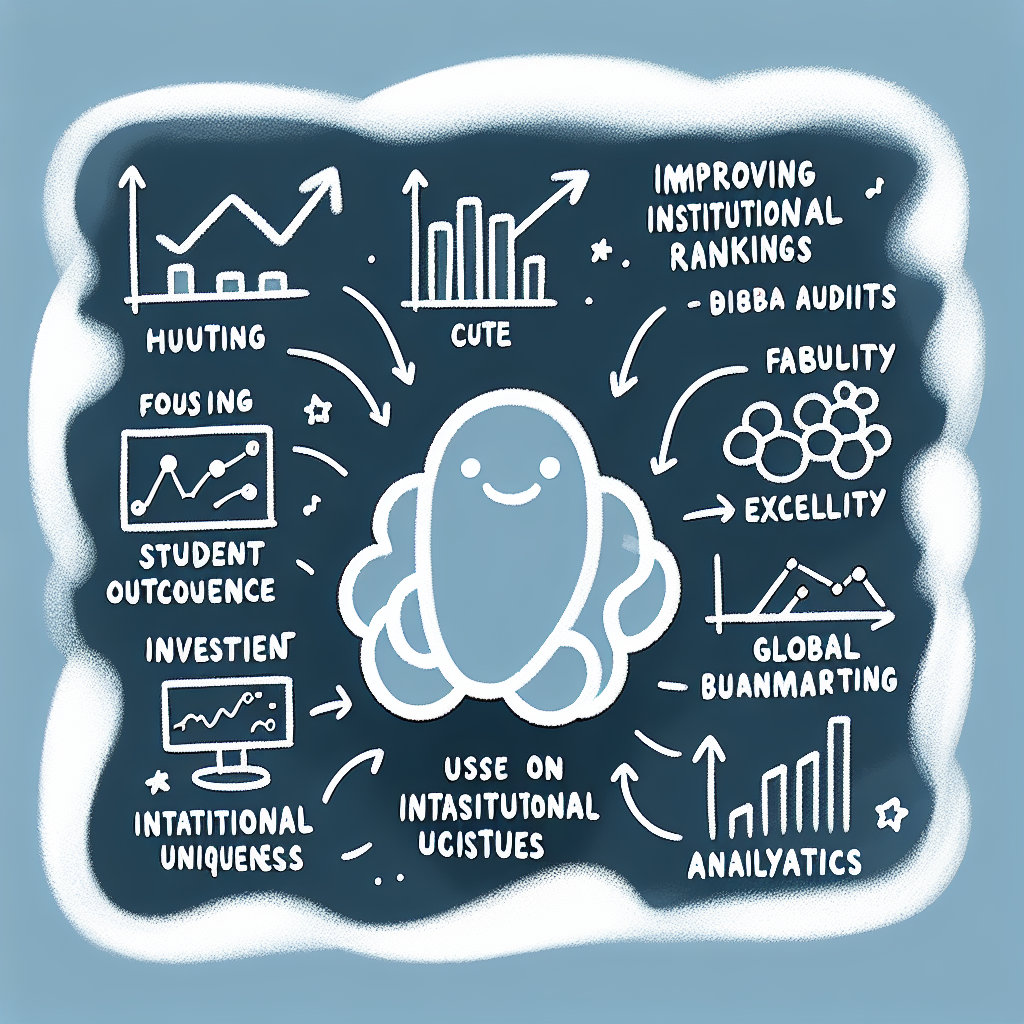Introduction
The Growing Importance of University Rankings
Understanding how to increase chances of achieving a higher position in global university rankings has become a strategic priority for many institutions. Rankings now play a critical role in shaping decisions across academia. They influence student enrollment patterns, affect faculty recruitment and retention, impact funding opportunities, and shape international collaborations. As a result, rankings are no longer ancillary—they are central indicators of institutional prestige and global competitiveness.
Purpose of This Guide
This guide focuses on how to increase chances of improving a university’s standing in widely recognized rankings. It offers a structured roadmap for institutions seeking to enhance their performance across the key metrics used by ranking bodies. Drawing from a range of studies and expert analyses, this guide synthesizes data-driven insights and evidence-based strategies to support universities in navigating the complex landscape of academic rankings.

Understanding Ranking Methodologies
To learn how to increase chances of gaining admission to top institutions, it's important to understand how college and university rankings are calculated.
Dissecting Key Ranking Systems
Different ranking systems use distinct methodologies. For example, the U.S. News & World Report ranking includes several weighted factors:
- Peer assessment: Surveys sent to academic officials to gauge reputation.
- Faculty resources: Metrics like class size, faculty salary, and faculty degrees.
- Retention and graduation rates: Indicators of student satisfaction and success.
- Student selectivity: Test scores, class rank, and acceptance rate.
Other influential ranking systems include:
- QS World University Rankings: Emphasizes academic reputation, employer reputation, and international diversity.
- Times Higher Education (THE): Focuses on teaching, research, citations, international outlook, and industry income.
- Shanghai Rankings (Academic Ranking of World Universities): Primarily highlights research output and Nobel Prize winners.
Understanding these systems can help applicants tailor their strategy to target schools that align with their strengths.
Shortcomings and Critiques of Rankings
Despite their influence, rankings have limitations. According to The Role & Rule of Rankings, many systems overemphasize research output and institutional prestige. They often fail to account for an institution’s mission, commitment to equity, or community impact.
Critics recommend broadening ranking criteria to reflect a wider range of institutional goals. This more inclusive approach can help students better understand how to increase chances of finding schools that match their values and aspirations.

Data-Driven Strategy Development
Developing a data-driven strategy is essential when exploring how to increase chances of success in complex, competitive environments. Leveraging interpretable machine learning, visual analytics, and predictive modeling allows institutions and organizations to make informed, strategic decisions.
Role of Interpretable Machine Learning
Interpretable machine learning plays a key role in identifying actionable insights. For example, the study "Strategizing University Rank Improvement using Interpretable Machine Learning and Data Visualization" demonstrates how decision tree algorithms can uncover the underlying factors that influence university rankings. These models prioritize transparency, allowing stakeholders to understand why certain variables impact outcomes—critical when making strategic decisions on how to increase chances of improvement.
Visualization for Strategic Insights
Data dashboards and visual analytics provide a clear view of institutional performance. By tracking key performance indicators (KPIs) across departments and over time, decision-makers can identify gaps and opportunities. These visual tools are instrumental in aligning initiatives with strategic goals, making it easier to see where efforts should be concentrated to increase chances of desired outcomes.
Predictive Modeling for Scenario Planning
Predictive modeling enables institutions to simulate the effects of strategic changes using historical data. This approach supports scenario planning, helping organizations understand potential risks and optimize resource allocation. By forecasting outcomes, predictive models contribute to more resilient and adaptive strategies, ultimately helping to increase chances of long-term success.

Key Factors that Increase Ranking Potential
Understanding how to increase chances of rising in academic rankings involves focusing on several critical areas. Universities that prioritize the following elements can significantly boost their visibility and performance metrics.
Academic Reputation
Academic reputation plays a central role in ranking methodologies. Institutions can increase their chances by enhancing faculty research output and visibility. Encouraging participation in academic conferences and increasing citation rates help build a stronger scholarly presence. Investing in research centers and fostering interdisciplinary initiatives further improves institutional prestige and academic influence.
Student Success Metrics
Improving student success metrics is essential for institutions seeking to learn how to increase chances of higher rankings. Key strategies include raising first-year retention and graduation rates, which signal academic quality and student satisfaction. Strengthening academic advising and offering robust student support services also contribute to better outcomes. Implementing bridge programs and learning communities can aid in student transition and engagement, further supporting institutional goals.
Faculty Resources
Well-supported faculty are crucial to institutional success. Maintaining low student-to-faculty ratios ensures personalized instruction and academic support. Increasing faculty qualifications through professional development funding and offering competitive salaries and research incentives help attract and retain top educators. These efforts are directly linked to improvements in academic performance and reputation.
Financial Resources and Alumni Giving
Financial stability underpins many ranking indicators. Expanding endowments and securing diverse external funding sources enable institutions to invest in academic programs and infrastructure. Building strong alumni networks and engagement strategies encourages giving, which reflects institutional loyalty and success. These financial inputs are key when considering how to increase chances of upward mobility in rankings.
Selectivity and Admissions
Selectivity is another important ranking factor. Enhancing recruitment strategies to attract high-achieving students improves the academic profile of incoming classes. Offering competitive financial aid packages ensures access and affordability, attracting a broader pool of qualified applicants. Promoting institutional reputation through targeted outreach helps increase applications and yield rates, further elevating selectivity metrics.

Strategic Institutional Interventions
Strategic institutional interventions are essential for colleges and universities seeking how to increase chances of recognition, funding, and student enrollment. Institutions can maximize their impact by focusing on mission alignment, leveraging rankings, and promoting transparency.
Emphasizing Institutional Mission and Uniqueness
Highlighting and aligning with an institution’s unique mission can significantly increase chances of standing out in a crowded academic landscape. According to The Role & Rule of Rankings, colleges that position themselves around niche strengths—whether in liberal arts, STEM, or community engagement—are more likely to differentiate themselves in meaningful ways. This differentiation strategy not only boosts visibility but also attracts students and faculty who align with the institution's values and strengths.
Leveraging Existing Rankings
Institutions can further increase chances of success by actively using their current rankings to their advantage. As outlined in Leveraging Your U.S. News & World Report Ranking, schools should promote any ranking improvements or achievements in their marketing materials. Rankings can also serve as a tool for attracting new partnerships and funding opportunities, especially when the improvements are framed within broader strategic goals.
Institutional Transparency and Accountability
Publishing clear, accessible data on institutional performance, goals, and progress is another way to increase chances of stakeholder trust and engagement. When institutions are transparent and involve faculty, staff, students, and external partners in ongoing improvement processes, they build a culture of accountability. This not only supports internal development but also enhances the institution’s public image and credibility.

📊 The Impact of Analytics on Reputation
Understanding how to increase chances of improving institutional reputation involves leveraging analytics effectively. Colleges and universities are increasingly turning to data analysis to guide strategic decisions that enhance both internal performance and external perception.
Data-backed insights allow institutions to identify performance bottlenecks—such as low graduation rates or inefficient administrative processes—and take targeted action to address them. These improvements not only streamline operations but also contribute to better outcomes for students, which can boost overall institutional standing.
Moreover, analytics play a direct role in influencing college rankings and public reputation. As outlined in Analytics Influence on College Rankings and Reputation, data-driven strategies enable schools to showcase measurable improvements in key performance indicators. These metrics often feed into ranking algorithms and public reporting, making analytics a critical tool in shaping how institutions are perceived externally.
In essence, by integrating analytics into decision-making processes, colleges can systematically increase their chances of improving reputation and climbing in national and global rankings.

Policy Implications and Governance
Effective governance and policy reforms are essential when considering how to increase chances of improving institutional rankings. Internal and external policy adjustments can directly impact performance metrics and ensure long-term sustainability.
Internal Policy Reforms for Sustained Improvement
To increase chances of advancing in rankings, institutions should integrate ranking objectives into their strategic plans. This ensures that performance goals are aligned across departments and embedded in operational frameworks. Resource allocation must be data-driven, focusing on initiatives that demonstrate measurable impact on key ranking indicators such as research output, international collaboration, and student satisfaction.
Creating dedicated task forces or ranking committees within departments can support consistent monitoring and execution of ranking-related strategies. These groups can coordinate efforts, track progress, and recommend policy adjustments in response to performance gaps.
External Policy and Accreditation Considerations
Institutions should align their internal metrics with both national and international quality standards. Doing so not only increases transparency but also ensures comparability across peer institutions. This alignment supports efforts to increase chances of recognition in global ranking systems.
Engaging proactively with accrediting bodies is also critical. Accreditation status often influences ranking methodologies and public perception. Maintaining compliance with evolving accreditation criteria enhances both institutional credibility and ranking performance.

Conclusion and Forward Strategy
Summary of Actionable Insights
Understanding how to increase chances in institutional rankings demands a multidimensional strategy. Success is not driven by a single factor but by a holistic, data-informed approach that touches on various aspects of university operations. Prioritizing student outcomes, faculty excellence, and institutional distinctiveness is essential to improving performance across ranking metrics.
Recommendations for Future Action
To effectively increase chances of improving rankings, institutions should begin by conducting regular audits and updates of their institutional data to ensure accuracy and alignment with ranking criteria. Investing in analytics infrastructure and dedicated staff can provide the capacity to track, model, and optimize performance indicators. Additionally, fostering a culture of continuous improvement and evidence-based strategy will empower stakeholders to make informed decisions and drive sustained progress.
Future Research and Innovation
Looking ahead, institutions should explore AI-driven forecasting tools that can predict changes in ranking methodologies and trends. Developing robust global benchmarking tools will also help universities compare their performance with peers across different regions. Finally, embracing open-source collaboration in higher education analytics can lead to shared solutions and innovations that benefit the broader academic community.














